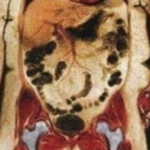Introduction
In the quest for a healthier body, many of us grapple with the challenge of losing fat. But not all fat is created equal. There are two main types: visceral fat and subcutaneous fat. So, which one is easier to lose? Let’s dive into this fascinating topic and uncover the secrets to shedding these different types of fat.
1. Understanding Visceral Fat
Visceral fat is the deep fat that wraps around your internal organs, including your liver, pancreas, and intestines. It’s often referred to as “hidden fat” because it’s not visible to the naked eye.
Why It’s a Problem
Visceral fat is particularly dangerous because it’s associated with a higher risk of serious health issues, including heart disease, diabetes, and certain cancers.
How to Identify It
You can’t see visceral fat, but you can often feel its effects. If you have a larger waistline or a “beer belly,” chances are you have excess visceral fat.
2. Understanding Subcutaneous Fat
Subcutaneous fat is the fat stored just under your skin. It’s the type you can pinch on your arms, legs, and belly.
Why It’s Less Risky
While subcutaneous fat is more visible and can affect your appearance, it’s generally less harmful than visceral fat. However, it can still contribute to overall health issues if present in large amounts.
How to Identify It
If you can pinch it, it’s subcutaneous fat. This fat is more evenly distributed around your body and is easier to notice.
3. The Battle of the Fats: Which Is Easier to Lose?
Now that we understand the two types of fat, let’s address the million-dollar question: Which one is easier to lose?
Visceral Fat: The Easier Target
Believe it or not, visceral fat is often easier to lose than subcutaneous fat. This is because visceral fat is more metabolically active and responds better to diet and exercise changes.
Subcutaneous Fat: The Stubborn Layer
Subcutaneous fat tends to be more stubborn. It requires a more targeted approach, combining diet, exercise, and sometimes specific treatments to effectively reduce.
4. Effective Strategies to Lose Visceral Fat
Here are some proven strategies to tackle visceral fat:
Healthy Diet
Focus on a balanced diet rich in whole foods, lean proteins, healthy fats, and plenty of fruits and vegetables. Avoid processed foods, sugary drinks, and excessive alcohol.
Regular Exercise
Engage in regular physical activity, including aerobic exercises like walking, running, and cycling. Strength training can also help by building muscle and boosting metabolism.
Stress Management
High stress levels can increase cortisol, a hormone that promotes visceral fat accumulation. Practice stress-relieving activities like yoga, meditation, and deep breathing exercises.
Adequate Sleep
Getting enough quality sleep is crucial. Aim for 7-9 hours per night to support overall health and fat loss.
5. Effective Strategies to Lose Subcutaneous Fat
Reducing subcutaneous fat requires consistency and patience:
Targeted Workouts
Incorporate exercises that target specific areas where subcutaneous fat is more prevalent. This includes strength training and toning exercises.
Hydration
Staying hydrated helps your body function optimally and can assist in fat loss. Aim to drink at least 8 cups of water a day.
Consistent Routine
Consistency is key. Stick to your healthy eating and exercise routines to see gradual improvements in subcutaneous fat reduction.
6. The Role of Genetics
It’s important to note that genetics play a significant role in where your body stores fat and how easily you can lose it. Some people may find it easier to lose visceral fat, while others may struggle more with subcutaneous fat.
Conclusion
While losing fat is a common goal, understanding the differences between visceral and subcutaneous fat is crucial. Visceral fat, though more dangerous, is often easier to lose with lifestyle changes. Subcutaneous fat, while less harmful, can be more stubborn and requires a targeted approach. By adopting a healthy diet, regular exercise, and other effective strategies, you can work towards reducing both types of fat and achieving a healthier, more balanced body.
FAQs
1. Can you target visceral fat specifically? No, you can’t target visceral fat specifically, but overall weight loss through diet and exercise will help reduce it.
2. Is visceral fat always visible? No, visceral fat is not visible as it’s located deep within your abdomen around your organs.
3. Why is subcutaneous fat harder to lose? Subcutaneous fat is less metabolically active, making it more resistant to weight loss efforts.
4. Can genetics affect where you store fat? Yes, genetics play a significant role in fat distribution and loss.
5. What exercises are best for losing subcutaneous fat? A combination of strength training and aerobic exercises is most effective for reducing subcutaneous fat.





